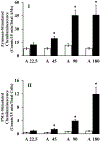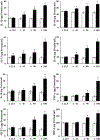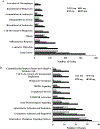Pulmonary toxicity and gene expression changes in response to whole-body inhalation exposure to multi-walled carbon nanotubes in rats
- PMID: 35648795
- PMCID: PMC9885491
- DOI: 10.1080/08958378.2022.2081386
Pulmonary toxicity and gene expression changes in response to whole-body inhalation exposure to multi-walled carbon nanotubes in rats
Abstract
Purpose: To investigate the molecular mechanisms underlying the pulmonary toxicity induced by exposure to one form of multi-walled carbon nanotubes (MWCNT-7).Materials and methods: Rats were exposed, by whole-body inhalation, to air or an aerosol containing MWCNT-7 particles at target cumulative doses (concentration x time) ranging from 22.5 to 180 (mg/m3)h over a three-day (6 hours/day) period and toxicity and global gene expression profiles were determined in the lungs.Results: MWCNT-7 particles, associated with alveolar macrophages (AMs), were detected in rat lungs following the exposure. Mild to moderate lung pathological changes consisting of increased cellularity, thickening of the alveolar wall, alveolitis, fibrosis, and granuloma formation were detected. Bronchoalveolar lavage (BAL) toxicity parameters such as lactate dehydrogenase activity, number of AMs and polymorphonuclear leukocytes (PMNs), intracellular oxidant generation by phagocytes, and levels of cytokines were significantly (p < 0.05) increased in response to exposure to MWCNT-7. Global gene expression profiling identified several significantly differentially expressed genes (fold change >1.5 and FDR p value <0.05) in all the MWCNT-7 exposed rats. Bioinformatic analysis of the gene expression data identified significant enrichment of several diseases/biological function categories (for example, cancer, leukocyte migration, inflammatory response, mitosis, and movement of phagocytes) and canonical pathways (for example, kinetochore metaphase signaling pathway, granulocyte and agranulocyte adhesion and diapedesis, acute phase response, and LXR/RXR activation). The alterations in the lung toxicity parameters and gene expression changes exhibited a dose-response to the MWCNT exposure.Conclusions: Taken together, the data provided insights into the molecular mechanisms underlying the pulmonary toxicity induced by inhalation exposure of rats to MWCNT-7.
Keywords: Multi-walled carbon nanotubes; fibrosis; inflammation; lung toxicity; molecular mechanisms.
Conflict of interest statement
Disclosure statement
No potential conflict of interest was reported by the author(s). The findings and conclusions in this report are those of the authors and do not necessarily represent the official position of the National Institute for Occupational Safety and Health, Centers for Disease Control and Prevention. The Next Generation Sequence data discussed in this publication have been deposited in NCBI’s Gene Expression Omnibus (GEO) and are accessible through GEO Series accession number GSE148869.
Figures








References
-
- Andrews S. 2010. FastQC: a quality control tool for high throughput sequence data http://www.bioinformatics.babraham.ac.uk/projects/fastqc.
-
- Anjilvel S, Asgharian B. 1995. A multiple-path model of particle deposition in the rat lung. Fundam Appl Toxicol 28(1):41–50. - PubMed
-
- Asakura M, Sasaki T, Sugiyama T, Takaya M, Koda S, Nagano K, Arito H, Fukushima S. 2010. Genotoxicity and cytotoxicity of multi-wall carbon nanotubes in cultured Chinese hamster lung cells in comparison with chrysotile A fibers. J Occup Health 52(3):155–166. - PubMed
Publication types
MeSH terms
Substances
Grants and funding
LinkOut - more resources
Full Text Sources
Molecular Biology Databases
